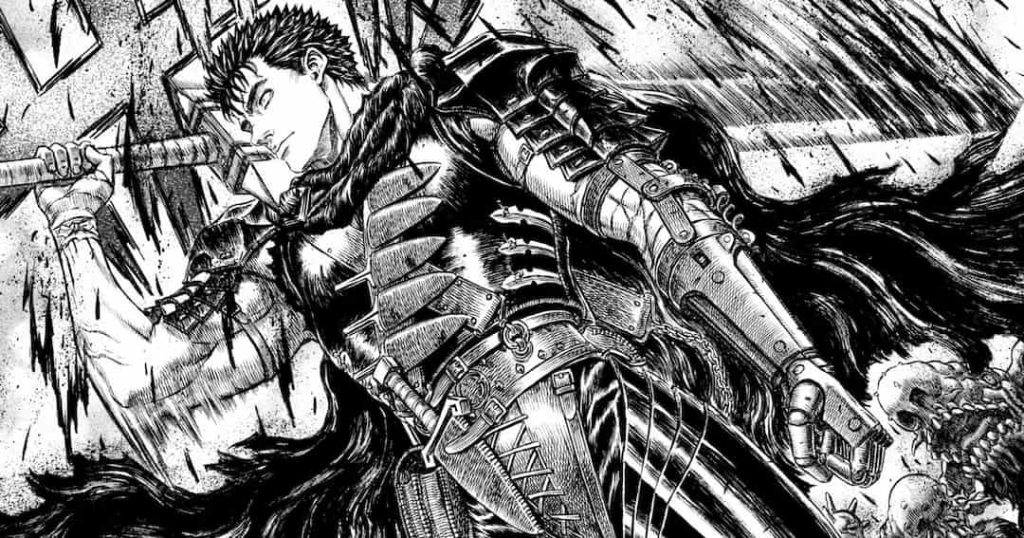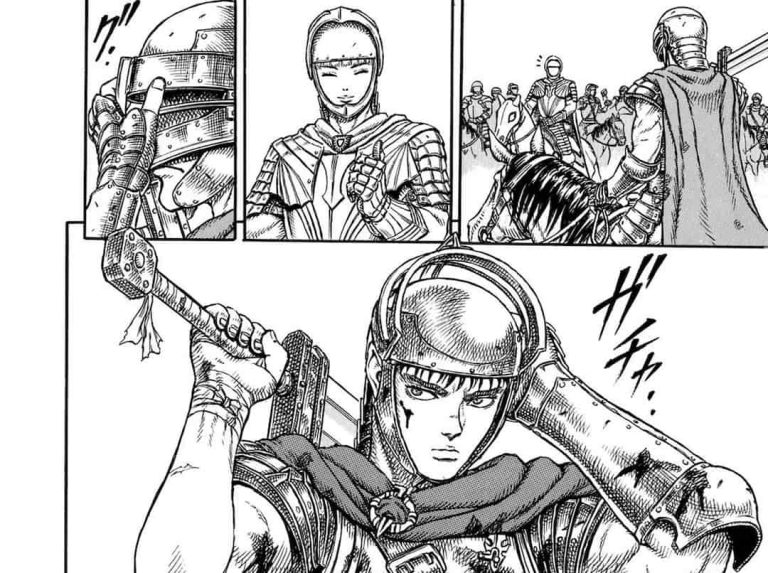Visual storytelling on the first page of Berserk: A masterclass by Kentaro Miura
Kentaro Miura’s Berserk is widely regarded as a masterpiece in the manga world. Its compelling storytelling, complex characters, and dark tone make it stand out. Miura’s skilful visual storytelling through shading, character design, and panel layout is particularly noteworthy. In this article, we’ll explore how the first page of Berserk sets the stage for the entire series through its visual storytelling.

The visual importance of the first page of Berserk
The first page of any manga holds great significance as it sets the stage for the reader’s journey into the world the creator has built. As such, the first page of Berserk is packed with visual cues that communicate the dark and violent atmosphere of the series. Miura’s artwork draws readers in, even before any dialogue is presented.
The use of intricate details, heavy shading, and powerful imagery sets an immediate tone that resonates throughout the entire series. By carefully analyzing the first page of Berserk, we can understand how Miura uses visual elements to tell a story without needing to say a word.
Shading and lighting: To set a grim mood
The first page of Berserk by Miura is striking because of the way shading creates a dark and ominous atmosphere. The heavy use of black ink to make shadows gives the story a serious and grim feel. Miura pays a lot of attention to detail, and on this first page, the shading has a few important jobs.
First, the deep shadows make everything mysterious and unsettling. There’s a lot that’s unknown, and it makes readers feel tense as they try to figure out what’s going on in this world. The darkness in Miura’s art reflects the moral gray areas and violent chaos in the Berserk universe.
The shading also creates contrast. Miura puts the dark and light areas next to each other to make certain parts of the picture stand out, like the main character Guts’ shiny armour. This contrast not only makes important things easy to see but also shows that light and dark are always in conflict—both in the story and in the visuals.
Character design: The power of Guts’ first appearance
The way Guts is introduced in Berserk immediately conveys his nature and the story’s themes. On the first page, he is shown in his infamous Black Swordsman persona, with a harsh design that gives him a larger-than-life, almost monstrous appearance.
Guts makes a solid first impression with his tough and determined look, reflecting the harsh experiences that have shaped him. His massive sword shows the intense battles he faces, both externally and internally. Guts’ design highlights his role as a lone warrior in a world full of demons and monsters, symbolizing the constant struggle he endures.
Miura pays close attention to the details of Guts’ armour and weapons in Berserk. The worn-out, battered armour tells a story of countless battles, showing Guts’ toughness and survival skills without needing words. This visual storytelling helps readers quickly grasp the dangerous world of the story.
Panel layout: Creating a dynamic narrative flow
The panel layout is another essential aspect of Miura’s storytelling that is immediately evident on the first page of Berserk. Miura’s mastery of the manga form is demonstrated through his ability to use panel arrangements to control the pacing of the story, guide the reader’s eye, and convey emotional intensity.
The first page presents a bold and dynamic layout, with Miura choosing to fill it with large, detailed panels that focus primarily on Guts. This features a nearly full-page close-up of Guts that immediately sets him as the focal point of the story. The panel’s size gives weight to his presence, making it clear that he is a figure of great importance in this dark world.
Miura also skillfully manipulates the flow of movement within the panels. His use of diagonal lines and unconventional panel shapes creates a sense of unease and disorientation, mirroring Berserk’s chaotic and violent world. The layout is not rigid or predictable, which keeps the reader engaged and enhances the impact of the story being told visually.
Miura’s use of wide cinematic panels in Berserk helps to show the vastness of the world and the intensity of Guts’ battles. This technique is used right from the start, where Guts is shown as a large and imposing figure on the first page. By arranging the panels to direct the reader’s focus and create suspense, Miura ensures that the visuals play a significant role in telling the story.
Symbolism and visual metaphor: Telling a deeper story
The first page of Berserk is full of symbolism and visual metaphors. Guts is introduced as a solitary figure, cloaked in shadows and armed, symbolizing his internal struggles and the series’ themes. The use of darkness in shading and metaphorically represents the thematic darkness that follows Guts throughout the series.
The visual contrast between Guts and the world around him symbolizes his struggle against fate and the harsh realities of his world. This effectively communicates the relentless fight for survival, a key theme of Berserk, through the visual storytelling on the first page.
Miura’s ability to layer these symbolic elements within his artwork adds depth to Berserk, elevating it beyond simple visual entertainment. The first page captures the central themes of the series—struggle, survival, and the fight against darkness—through its art, long before the narrative explicitly reveals these ideas.
Closure
Kentaro Miura’s Berserk demonstrates the incredible power of visual storytelling from the very first page. The expert use of shading, character design, panel layout, and symbolism sets the tone and communicates the core themes without relying on dialogue or exposition. This mastery of visual elements draws readers into a rich and emotionally charged world, making it a masterclass in using visual language to convey mood, character, and narrative depth.
Miura’s artistic techniques immediately immerse readers in the dark and brutal world of Berserk, challenging them just as it challenges the protagonist, Guts. This powerful visual storytelling continues to inspire both readers and artists, solidifying Miura’s legacy as one of the greatest manga creators of all time.






